Withholding and Withdrawing Treatment
Through the miracles of modern medicine, many critically or terminally ill patients can maintain productive lives that include meaningful interactions with loved ones and other members of society. Yet sadly, others can be kept alive yet suffer greatly from their sickness, or alternatively, remain in a comatose or vegetative state.
Jewish ethics on the sensitive question of stopping life-sustaining therapies are generally guided by three key principles:
- One may not do any action to hasten death. No matter how short a time a person might have to live, we should never proactively do anything that causes death (i.e., to “extinguish the flickering candle,” as the Sages put it).
- One should not cause a patient to die more slowly. Interventions that merely extend the dying process, as opposed to therapies that prolong living, should not be pursued.
- One may remove an external impediment which is merely hindering the soul’s departure.
Keeping these principles in mind, we can understand how Jewish ethics views various proposals offered by Western medical care systems to the complexities of end-of-life care.
- Suicide: Jewish law prohibits death by intentionally ending one’s own life. While Judaism deeply sympathizes with the plight of the suffering patient, the Torah prohibits directly causing harm to oneself, even in painful circumstances. Judaism supports providing a suffering patient with the necessary therapies to alleviate their pain. It advocates for health care systems to provide quality hospice care as well as palliative treatments, including the use of morphine and other opioids toward the end of life. (See here for more details)
- Active Euthanasia and Medical Aid in Dying (MAID): Jewish law does not allow health care professionals to administer drugs directly intended to kill a suffering patient (euthanasia). Similarly, it does not allow them to provide the drugs to a patient or family member with that intent (sometimes known as physician-assisted suicide).
Judaism believes that health care providers play a sacred role in caring for the sick. Such “mercy killings” sully the lofty goals of medicine and compromise a healthcare provider’s mission to heal. Countries and states that permit euthanasia and physician-assisted suicide must respect the liberty of its religious (and other) health care professionals who conscientiously object to participating in such activities.
Withholding Treatment
Jewish ethics generally allows for passive acts of omission in which we withhold life-extending interventions from dying patients while providing them with comfort care. This approach is sometimes called “passive euthanasia.” That term can become confusing because it doesn’t distinguish between withholding and withdrawing interventions, as discussed below.
When we withhold treatments, we are letting nature take its course and “allowing” the person to die rather than doing something which actively causes or hastens their death.
Foregoing Treatment
Examples of treatments that one might forego if the patient or their proxy determine that there is no or minimal benefit to such interventions include:
- Surgery
- Radiation
- Vasopressors
Cyclical Interventions
Similarly, some treatments which are intermittent or cyclical may be stopped in-between sessions or cycles of treatments. These include:
- Dialysis
- Chemotherapy
- Implanted cardiac defibrillators
- Some forms of antibiotics and IV (Intravenous) treatments
- Artificial nutrition when it is “medically contraindicated,” i.e., the body can no longer absorb it or there is a significant risk for aspiration. (See here for more information).
Mechanical Ventilators and Other Continuous Interventions
More complex dilemmas arise with continuous forms of life-prolonging interventions that will not stop on their own. A good example of this is a mechanical ventilator (or “breathing machine”) that provides artificial respiration. A ventilator can frequently maintain respiration for an extended period even when there is no hope for recovery. You can learn more about extubation at end of life in the video below.
There are generally three different approaches to this specific device:
i) Most argue that one should not withdraw an artificial respirator (or other critical interventions) as this will directly hasten the patient’s death, even if intubation is no longer deemed medically advisable. However, one would not necessarily need to reconnect the machine if its functioning had to be interrupted anyway to service it or suction the patient.
ii) Another approach is that the artificial respirator becomes, in these circumstances, an external impediment to death that doctors should remove to prevent the prolonging of the death process (following principle #3 above).
iii) A compromise position asserts that one may extubate the patient if they can remain stable without the ventilator for some ‘significant’ amount of time, or b) to allow the oxygen rate of the ventilator to be carefully lowered to the level found in the normal air which we breathe, provided that the patient can still breathe on their own. One would not later be required to increase the oxygen saturation if the patient’s condition became unstable. Please note that these two disputed solutions are not always medically feasible.
Given the complexities of these cases, Ematai makes the following two recommendations:
- Before an acute crisis occurs, people should discuss with their proxy, close family and friends, caretakers, rabbis, and healthcare providers their general preferences regarding end-of-life care interventions. Ematai’s conversation primer is meant to facilitate those discussions.
- Before any key decision is made, a group conversation should be held with the patient (when possible), their proxy and close family members, the primary healthcare provider, and one’s rabbi. Ematai’s hotline is always available for consultation.




